US Corporate Earnings Peaking - Shift into Defensive Growth Stocks
Stock-Markets / Corporate Earnings May 17, 2011 - 12:45 PM GMTBy: Rory_Gillen
 The recovery in global stock markets, which started in mid March 2009, is just over two years old. Many commentators feel that the recovery is illusory, based on cheap money from central banks and reckless fiscal spending by governments desperate to stave off recession and rising unemployment. Others see an improving global economy with the emerging markets as the new locomotive of world growth underpinned by rising populations, the urbanisation of China and India in particular and the consequent growth in emerging economy middle class incomes, which has brought some two billion consumers into the global economy.
The recovery in global stock markets, which started in mid March 2009, is just over two years old. Many commentators feel that the recovery is illusory, based on cheap money from central banks and reckless fiscal spending by governments desperate to stave off recession and rising unemployment. Others see an improving global economy with the emerging markets as the new locomotive of world growth underpinned by rising populations, the urbanisation of China and India in particular and the consequent growth in emerging economy middle class incomes, which has brought some two billion consumers into the global economy.
There is no doubting that the global economy is unbalanced - debt is too high in many developed economies and consistent trade imbalances remain a destabilising force. But that is the macro view and very hard for anyone to draw a conclusion from.
If we focus on the world’s largest and most influential equity market, the US S&P 500, there are only a couple of key variables that determine how cheap or expensive the market is relative to history. Those variables include;
- The trend of US corporate earnings
- The levels of corporate earnings versus overall economic output in the US
- and competition from interest rates (or bond yields)
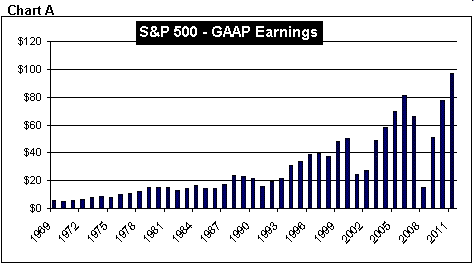
US Corporate Earnings
Chart A highlights the long term trend in earnings in the 500 companies making up the S&P 500 Index. This is a diverse index made up of companies across a broad range of sectors aimed at representing the US economy. The chart makes a few key points. The first is that analysts at Standard & Poors expect earnings of $96 for the S&P 500 Index in 2011, a new peak in earnings. In addition, this has been one of the fastest recoveries in earnings following recession in history.
At the current S&P 500 index level of 1,341 (at the time of writing), the $96 of earnings means that investors are paying 14 times expected 2011 earnings, which is at or around the long term average investors have paid over the long term (see Chart B). No worries so far!
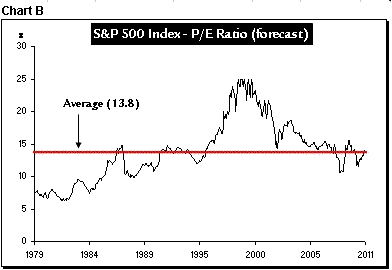
Corporate Earnings versus Economic Output
But we must also remember that the level of corporate earnings is a function of economic output and, over time, there tends to be a fairly stable relationship between the how much of the economic pie goes to companies and how much to other parts of society like labour (or wages).
Chart C shows that US corporate pre tax earnings have averaged circa 10% of GDP through all the business and economic cycles since 1960, some 50 years of data. Currently, US earnings are at 12.2% of GDP which is some 20% ahead of the long term norm. This is reason enough to query whether the market is being overly optimistic in expecting earnings for the S&P 500 companies to rise further this year from $87 to $96. History suggests the opposite if more likely – that US earnings are more likely to revert to the mean and back towards the long term average of 10% of GDP. US corporate profits are a function of economic output and cannot outgrow the economy for long.
Chart C, therefore, paints an altogether more sobering picture - one where current earnings in the US economy are already back to near a peak when compared to economic output. Hence, while investors appear to be paying fair value of 14 times US earnings they are paying that for peak earnings. On that basis, we might conclude that the valuation of the US equity market is some 20% above long term norm and, therefore, overvalued in the short term.
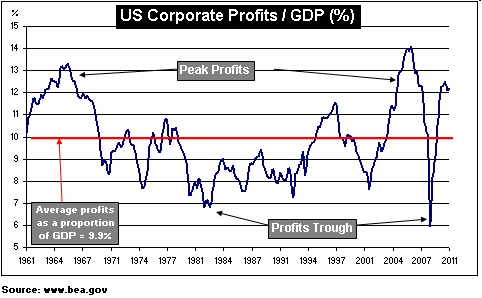
Assets Can’t be Valued in a Vacuum
But the tricky part comes next. The valuation of any asset class has to be judged against the alternatives. Accountants have no problem with numbers so I will use more here. In 1999, the US equity market was trading on circa 25 times prospective earnings. That can be equally expressed as an earnings yield of 4.0% i.e. the S&P 500 earnings, in aggregate, represented 4.0% on the price being paid. The trouble at that time was that the risk-free US government 10-year bond was offering a yield of 6.3%. In other words, the value lay in US bonds. The subsequent ten years have delivered miserable return to investors in the US stock market, not due to bad luck or recessions but due to the simple fact that equities were grossly overvalued relative to history and the simple alternative of bonds at that time.
Roll forward to 2011 and the issue is not anywhere near as clear cut. If we accept that the 500 companies making up the S&P 500 will earn $96 dollars in 2011 and that the market remains at the current level of 1,341, then the US equity market currently offers an earnings yield of 7.2%. In comparison, the US 10-year government bond yields 3.3% (at the time of writing).
In 1999, the value in US bonds over US equities was clear. Today, it appears that US equities offer a higher earnings yield than US bonds. But the certainty one attaches to peak earnings must be low, and a betting man would assume that US earnings cannot hold their current levels.
This probably leaves us in no-man’s land! US government 10-year bonds look unattractive and US equities, while potentially cheap versus bonds, are possibly 20% overvalued when looked at in isolation relative to the long term norm.
But pockets of value exist and value investing is all about understanding that the return you get is heavily linked to the value you buy (or price you pay) at the outset.
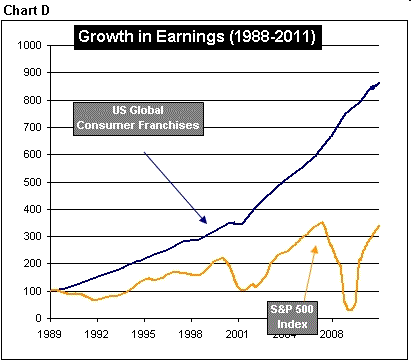
Chart D highlights the radically different earnings profile of the US global consumer franchise stocks. This chart averages the earnings of eight such companies since 1989 – Coca Cola, Kraft, Johnson & Johnson, Kellogg, McDonalds, Wal-Mart, Proctor & Gamble & Colgate – and compares their earnings to the S&P 500. Not only have these great companies grown their earnings at double the pace but they have done so with little or no interruption i.e. they possess the elusive ‘Reliability of Earnings’ factor.
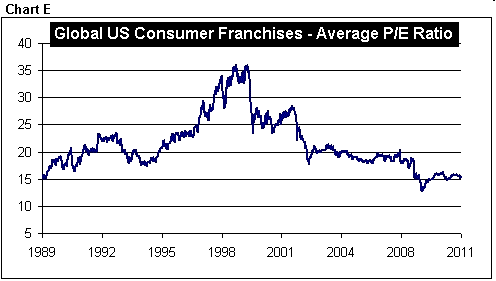
And reliability of earnings combined with an ability to grow should be highly prised by investors. But Chart E highlights that this collection of stocks is available on an average price-to-earnings rating of 15, as low a rating in quite some time.
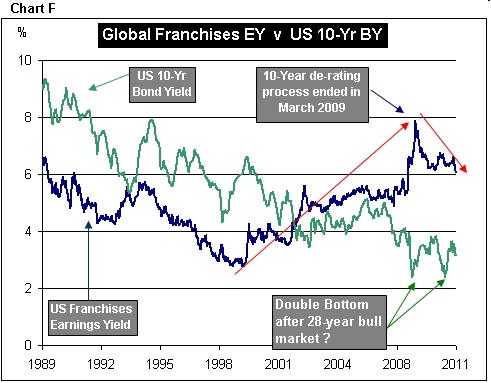
And finally, a price-to-earnings ratio of 16.4 equates to an earnings yield of 6.1% which is almost double the current 10-year bond yield of 3.19% (Chart F). And bonds offer no growth. For these reasons, I’d own these stocks before I’d buy the S&P 500 Index or American stocks in general or US government bonds.
Rory Gillen
Founder
www.investRcentre.com
Rory Gillen is a qualified Chartered Accountant, a former equity analyst, stockbroker and fund manager who has spent over twenty years working in the financial services industry. He founded The InvestR Centre in 2005 as a stock market training company. www.investrcentre.com
© 2011 Copyright Rory Gillen - All Rights Reserved Disclaimer: The above is a matter of opinion provided for general information purposes only and is not intended as investment advice. Information and analysis above are derived from sources and utilising methods believed to be reliable, but we cannot accept responsibility for any losses you may incur as a result of this analysis. Individuals should consult with their personal financial advisors.
© 2005-2022 http://www.MarketOracle.co.uk - The Market Oracle is a FREE Daily Financial Markets Analysis & Forecasting online publication.



